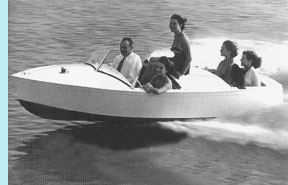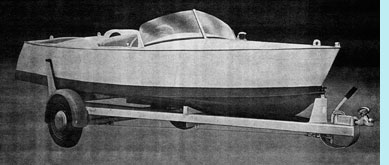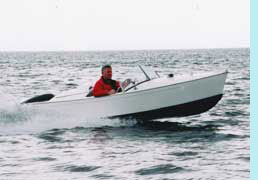|
HISTORY
 A
little while ago the renowned Simmonds and sports boat
expert Alan Fawcus wrote a short article about Donald
Simmonds, his company and the boats he built. We are
very grateful to Alan for his permission to use that
piece as a basis for our own history of Simmonds Motor
Launches . . . A
little while ago the renowned Simmonds and sports boat
expert Alan Fawcus wrote a short article about Donald
Simmonds, his company and the boats he built. We are
very grateful to Alan for his permission to use that
piece as a basis for our own history of Simmonds Motor
Launches . . .
Those
with long memories may remember Donald Leighton Simmonds
as being the person responsible for introducing self-drive
motorboats on the Thames at Richmond in 1946, but there
was far more to the man than that, and his career in
engineering began in a very high-profile environment.
Born in Wigton, Cumbria in June 1907, excitement came
early to Donald as, shortly after completing his apprenticeship
with Roll Royce, he joined the crew of the R100. This
airship was built by the Airship Guarantee Company at
Howden in Yorkshire and had been fitted with six Rolls
Royce engines. Donald's job was to tend those powerful
monsters.
 He
kept with the R100 through all its proving flights,
including its memorable trans-Atlantic crossing, until
disaster hit the R100's sister ship, the R101 during
its maiden flight on October 5th 1930. With the airship
projects scrapped Donald joined the Royal Aircraft Establishment
at Farnborough and concentrated on engine testing and
research. He remained there for five years before transferring
to Napiers, initially at the Acton works, but then moving
to Wright Field Ohio in the United States to test the
Napier Sabre engine in 1941. He
kept with the R100 through all its proving flights,
including its memorable trans-Atlantic crossing, until
disaster hit the R100's sister ship, the R101 during
its maiden flight on October 5th 1930. With the airship
projects scrapped Donald joined the Royal Aircraft Establishment
at Farnborough and concentrated on engine testing and
research. He remained there for five years before transferring
to Napiers, initially at the Acton works, but then moving
to Wright Field Ohio in the United States to test the
Napier Sabre engine in 1941.
He
left Napiers after the Second World War to set up and
operate a self-drive motorboat company at Richmond.
In 1946 twenty blue-painted boats were built and used
for pleasure by the public on the River Thames. His
interests also ran to racing motorboats, and in 1954
his outboard hydroplane Wollibong won the Daily
Mirror National Group Handicap and the first National
50 mile race.
In
1952 he embarked upon the task of designing his own
fast aluminium motorboat using a Ford 1500 cc engine.
The development and production of the craft proceeded
without haste for two years until the prototype had
its first public appearance at the Ruislip Lido Waterski
meeting in September 1954. This event was, perhaps a
little surprisingly, broadcast live on the BBC, but
it was an innovation that served Donald Simmonds well.
 Designed
to serve the purpose of towing waterskiers, as well
as being capable of acting as a yacht tender or runabout,
the boat readily attained a speed of some 35 mph. Powered
by a marinised Ford 1.5 litre straight four (also available
separately for £197), the engine in the prototype
was installed on Silentbloc mountings and cooled by
a heat exchanger built into the hull. A clutch was provided,
operated by a lever on the starboard side, and due to
the angle of the engine a bulge was put into the boat
bottom to accommodate the sump. This did not affect
the handling unduly but was done away with when production
started using a low-line aluminium sump. Seating
was on buttoned cushions with three in front and two
behind. The boat was constructed using 12 and 14 swg
aluminium sheet, weighed 850 lbs, and was d 14 ft long,
5'4" wide. Designed
to serve the purpose of towing waterskiers, as well
as being capable of acting as a yacht tender or runabout,
the boat readily attained a speed of some 35 mph. Powered
by a marinised Ford 1.5 litre straight four (also available
separately for £197), the engine in the prototype
was installed on Silentbloc mountings and cooled by
a heat exchanger built into the hull. A clutch was provided,
operated by a lever on the starboard side, and due to
the angle of the engine a bulge was put into the boat
bottom to accommodate the sump. This did not affect
the handling unduly but was done away with when production
started using a low-line aluminium sump. Seating
was on buttoned cushions with three in front and two
behind. The boat was constructed using 12 and 14 swg
aluminium sheet, weighed 850 lbs, and was d 14 ft long,
5'4" wide.
Orders
came in from all over the world, including America,
France and Australia, as well as five from a royal family
in the Persian Gulf. Buoyed by such a positive reaction
(no doubt enhanced by the live outside broadcast!) Donald
Simmonds commenced manufacture. The first boat to come
off the production line, No. 1, went to David Brown,
the founder of Aston Martin sportscars, and was kept
on the deck of Brown's yacht, Marsaltese II,
often moored off the coast at Monte Carlo.
 However,
the design was soon stretched to 15 '4" in overall
length and the larger, less agricultural 1700 cc Ford
Consul MK II engine was fitted, completed with twin
Zenith carburettors, four-branch water cooled exhaust
manifold and angled aluminium sump. There was a built-in
oil cooler and Jabsco saltwater pump, which not only
cooled the oil but also the exhaust manifold before
discharging through the exhaust pipe. However,
the design was soon stretched to 15 '4" in overall
length and the larger, less agricultural 1700 cc Ford
Consul MK II engine was fitted, completed with twin
Zenith carburettors, four-branch water cooled exhaust
manifold and angled aluminium sump. There was a built-in
oil cooler and Jabsco saltwater pump, which not only
cooled the oil but also the exhaust manifold before
discharging through the exhaust pipe.
A twelve-gallon fuel tank with a dipstick and reserve
tap was fitted. Instrumentation was a tachometer, oil
pressure gauge, engine temperature and ammeter. A secret
ignition switch was fitted in the event of losing the
key. The propeller was aluminium nickel bronze, 9½"
diameter, made by Simmonds, and each was individually
numbered.
The
rate of production at Simmonds' workshops was limited
to around six boats a year, and great care was taken
to ensure a very high standard of build - a fact which
accounts for the generally excellent condition of the
few surviving boats. This type of work did not come
cheaply, and in 1957 the cost was £835 without
trailer. By comparison, the Ford Consul MK II car with
the same engine was a mere £545.
 On
May 3rd 1958, at the London Motorboat Racing Club, a
certificate was issued to one Simmonds recording a best
lap speed of 34.55 mph, which included sharp left and
right turns. Being exceptionally well made and fast
ensured that many more Simmonds boats found their way
onto the racing circuits. One boat owned by Mr S.F.
Pearson was called Optimist (F.T. Zlll) and
met with great success during the 1960 season. Employing
a Raymond Mays conversion on the Ford Consul engine,
including triple SU H6 carburrettors, the boat won the
Lady Brecknock Trophy at speeds reaching 50 mph This
boat was shown on the Simmonds stand at the boat show
at Olympia in 1961. There are also examples of the Simmonds
fitted with the Daimler Dart V8 engine, and these can
be good for 60 mph. On
May 3rd 1958, at the London Motorboat Racing Club, a
certificate was issued to one Simmonds recording a best
lap speed of 34.55 mph, which included sharp left and
right turns. Being exceptionally well made and fast
ensured that many more Simmonds boats found their way
onto the racing circuits. One boat owned by Mr S.F.
Pearson was called Optimist (F.T. Zlll) and
met with great success during the 1960 season. Employing
a Raymond Mays conversion on the Ford Consul engine,
including triple SU H6 carburrettors, the boat won the
Lady Brecknock Trophy at speeds reaching 50 mph This
boat was shown on the Simmonds stand at the boat show
at Olympia in 1961. There are also examples of the Simmonds
fitted with the Daimler Dart V8 engine, and these can
be good for 60 mph.
 In
1961 the business was sold to Major Wood of Huwood Engineering
of Gateshead. With his financial input there was a rapid
expansion of the production facility, and over the course
of the next three years approximately 200 more boats
were built, mainly for ski clubs. Regrettably, the programme
came just a few years too late for Simmonds. With the
rapid growth in popularity of cheaper fibre-glass speedboats,
the viability of manufacturing a labour-intensive aluminium-hulled
boat like the Simmonds soon became marginal. In 1963
production finally ceased. The following year Donald
Simmonds died at the very early age of just 57. In
1961 the business was sold to Major Wood of Huwood Engineering
of Gateshead. With his financial input there was a rapid
expansion of the production facility, and over the course
of the next three years approximately 200 more boats
were built, mainly for ski clubs. Regrettably, the programme
came just a few years too late for Simmonds. With the
rapid growth in popularity of cheaper fibre-glass speedboats,
the viability of manufacturing a labour-intensive aluminium-hulled
boat like the Simmonds soon became marginal. In 1963
production finally ceased. The following year Donald
Simmonds died at the very early age of just 57.
Simmonds
Today
Ironically,
most of the contemporary fibreglass boats that effectively
killed off boats like the Simmonds have long since been
broken up, but the survival rate of the Simmonds itself
is far better than once presumed. Over the last few
years the number of Simmonds boats known to exist has
steadily grown, and whereas fewer than a dozen were
believed to survive intact just ten years ago, that
number is now thought to exceed forty.
 It
is with some amusement that we note that a fair number
of these newcomers to the list are coming to light when
boat owners discover that their five-seater Albatross
isn't actually an Albatross at all, but a Simmonds with
a worthy history all its own. The fact that so few Simmonds
appear to retain their original VIN plates is half the
problem, but the unique shape and exceptional build-quality
of the genuine item regularly brings another Simmonds
to the surface. It
is with some amusement that we note that a fair number
of these newcomers to the list are coming to light when
boat owners discover that their five-seater Albatross
isn't actually an Albatross at all, but a Simmonds with
a worthy history all its own. The fact that so few Simmonds
appear to retain their original VIN plates is half the
problem, but the unique shape and exceptional build-quality
of the genuine item regularly brings another Simmonds
to the surface.
Not
surprisingly, that quality and aesthetically-pleasing
shape also accounts for a recent resurgence in value.
While it is still possible to pick up a Simmonds restoration
project for a few hundred pounds, good examples now
change hands (although rarely!) for anything up to £5,000.
When one considers that a comparable vessel new today
would cost anything upwards of £25,000, and embody
just a fraction of the character, then owning a classic
aluminium sports boat starts to become even more appealing.
This
register was founded in 2006 to foster interest in the
Simmonds, and to offer a resource and support for existing
owners. If that includes you, and we're not yet aware
of you or your boat, then please do contact
us.
With
thanks to Alan Fawcus for his permission to borrow his
article for the preparation of this brief history. If
you want to know more, there are other articles reproduced
within the In Print section
of the website that include additional facts and references.
|